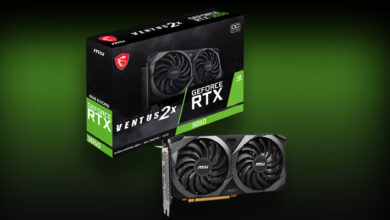
In recent weeks there has been a lot of hearsay and speculation on whether Intel’s graphics division, AXG, would end up getting canned. It’s not something I personally considered likely to happen but admittedly one of today’s top analysts did fear the worst. We still don’t exactly know what’s going on behind closed doors, nor will we likely get that sort of insight, but speaking to Intel this week I’m told it remains as dedicated as ever to its graphics roadmap—and that includes gaming graphics cards.
I’d just like to be clear: we’re not going anywhere.
Tom Petersen, Intel
“We’re not going anywhere on our discrete business. And our discrete business is the basic technology development that goes both into the data centre and integrated GPUs,” Intel’s Tom Petersen says.
I ask Petersen if that’s the message Intel wants to get across, and I receive an effusive “Yeah, we’re not going anywhere.”
“I feel like there’s a lot of FUD (fear, uncertainty, and doubt) out there. I’d just like to be clear: we’re not going anywhere,” he continues.
“The thing I happen to believe—Pat, and I, and Roger, and Lisa, and Ryan, everybody is aligned on the idea—that graphics is a critical technology to the client, is a critical technology to the data centre, and we want to start competing in the mainstream area where our competitors are making a tonne of money. So all three of those things are critically important for Intel.”
As I mentioned, this isn’t necessarily a promise that nothing will ever change in Intel’s approach to graphics, gaming, or otherwise. Still, those most closely aligned to its gaming graphics products are as committed as ever. Considering Intel has confirmed at least three more generations of Arc GPU on its roadmap—Battlemage, Celestial, and Druid—that’s good news.
Battlemage development has already kicked off, Petersen confirms, with the majority of Arc graphics engineers now turning their attention to the second generation. Some engineers are even looking into early Celestial “technology proof points.”
2nd Gen Battlemage cards are expected in 2023–24. (Image credit: Intel)
“Most of our ASIC team is on Battlemage,” Petersen says. “A small portion of it is on our future, which is Celestial. And then there’s a very small portion on Alchemist today, but they’re kind of different function sets. So like a board and, what I’ll call, chip teams are on Alchemist right now. Kind of think of it as getting our board just right, getting our BIOS just right, making all the final tuning. But the bulk of our design team is on Battlemage.
Though Intel does have a lot of work to do with its drivers, not just working on its not-so-great DX11 support but also continuing to support new and upcoming games on DX12 and Vulkan.
“The bulk of the driver team is on Alchemist, but there’s a small portion of the driver team, and it’s the same people it’s just like a portion of their time, working on Battlemage doing emulation, doing simulation, doing pre-silicon work. So that we have high confidence that we bring Battlemage to market more quickly with less surprises. With less growing pains.”
And Intel confirms that it remains dedicated to competing at the high-end with later generations of Arc, which so far its first generation has been unable to achieve.
“Our plan is to start here. And then we add on top and then we add on top. And it’s not a really hard strategy to understand because we’re starting with the volume segment of the market, and then we’ll grow into more high-performance segments over time.”
Intel’s Arc A770 and A750 graphics cards are expected to launch “very soon”. (Image credit: Future)
(Image credit: Corsair, Noctua)
Best CPU cooler: keep your chip chilled in style
Best PC fans: super-silent and plastered in RGB
Best PC cases: big, little, and everything in-between.
Though I also wondered if the delays to Alchemist’s response would have repercussions for Battlemage and a delayed release, yet both Petersen and colleague Ryan Shrout appeared confident in sticking to Intel’s plan for that. Ultimately Intel hasn’t released particularly specific dates for Battlemage on its current roadmaps, with only the loose promise of a 2023–24 window. So I’m not sure we can glean all that much as to Battlemage’s release date just yet, anyways.
Celestial is marked down for a 2024+ release window, which is about as vague as it could be. Druid hasn’t made much of an appearance past Intel’s Architecture Day slides from over a year ago, which never specified a launch year.
Basically: Intel has plenty of leeway for delivery of these graphics cards. We’ll see Nvidia and AMD turn the crank of another sure-to-be exciting GPU generation between now and then, too, so it’s absolutely likely some plans will change as a result.
For now, Intel is focusing on releasing its Alchemist 1st Gen cards, with the A770 and A750 expected imminently.






